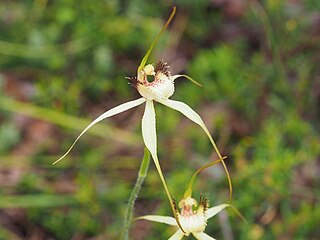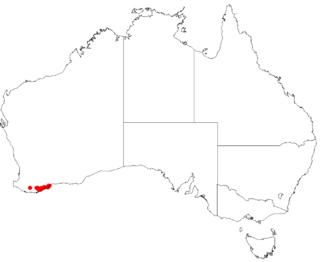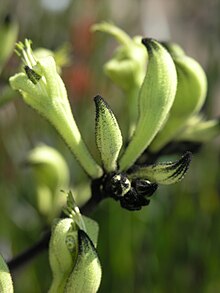
The coat of arms of Western Australia is the official coat of arms of the Australian state of Western Australia. It was granted by a royal warrant of Elizabeth II, Queen of Australia dated 17 March 1969.

Haemodoraceae is a family of perennial herbaceous flowering plants with 14 genera and 102 known species. It is sometimes known as the "bloodroot family". Primarily a Southern Hemisphere family, they are found in South Africa, Australia and New Guinea, and in the Americas. Perhaps the best known are the widely cultivated and unusual kangaroo paws from Australia, of the two closely related genera Anigozanthos and Macropidia.

Anigozanthos is a genus of Southwest Australian plants of the bloodwort family Haemodoraceae. The 11 species and their subspecies are commonly known as kangaroo paw or catspaw, depending on their size, and the shape and color of their flowers. A further species, previously identified as Anigozanthos fuliginosus, was separated to a monotypic genus as Macropidia fuliginosa.
Mangles is the name of a wealthy English family whose members had amongst other things, interests in the Swan River Colony.

Anigozanthos manglesii, commonly known as the red-and-green kangaroo paw, Mangles' kangaroo paw, kurulbrang (Noongar), is a plant species endemic to Western Australia, and the floral emblem of that state.

Macropidia fuliginosa, the sole species of genus Macropidia, is a perennial rhizomatous flowering plant. A relation of the kangaroo paws, Anigozanthus, which are also endemic to Southwest Australia, it is referred to as the black kangaroo paw. Bearing unusual black and green flowers, it occurs on a coastal plain from Perth to Geraldton.

Conostylis is a genus of perennial herbs in the Haemodoraceae family, commonly known as cone flowers. All species are endemic to the south west of Western Australia.

Anigozanthos humilis is a species of Anigozanthos in the family Haemodoraceae. This flowering perennial plant is endemic to Southwest Australia and widespread in its open forests. Common names include catspaw and common catspaw.

Anigozanthos flavidus is a species of plant found in Southwest Australia. It is member of the Haemodoraceae family. It is commonly known as the tall, yellow, or evergreen, kangaroo paw. The specific epithet, flavidus, refers to the yellow flowers of this plant.
James Mangles was an officer of the Royal Navy, naturalist, horticulturalist and writer. He served during the French Revolutionary and Napoleonic Wars, rising to the rank of captain. In the post-war period, with his brothers Robert and George, who shared his interests in horticulture, botany and plant collection, James was actively involved in the botanical, horticultural and commercial life of early colonial Western Australia.

Sandy iris is a species in the genus Iris; it is also in the subgenus of Iris and in the Psammiris section. It is a rhizomatous perennial, from Central Europe, found in Hungary, Austria, Romania, Czech Republic and Ukraine. It has grass-like leaves, a short stem and pale yellow flowers. It has had a mixed origin and was once Iris humilis subsp. arenaria, a subspecies of Iris humilis, until it was reclassified as a separate species. But many sources still state that it is either a synonym or subspecies of Iris humilis. It is cultivated as an ornamental plant in temperate regions.

Caladenia busselliana, commonly known as Bussell's spider orchid, is a plant in the orchid family Orchidaceae and is endemic to a small area in the south-west of Western Australia. It is a rare orchid with an erect, hairy leaf and up to three pale yellow flowers. Only about fifty specimens are known and it is threatened by habitat destruction and by too-frequent or too infrequent bushfires.

Xanthorrhoea gracilis, commonly known as the graceful grasstree, grassboy or mimidi, is a species of grasstree of the genus Xanthorrhoea native to Western Australia.

Anigozanthos gabrielae is a species of Anigozanthos in the family Haemodoraceae known as dwarf kangaroo paw. This flowering, rhizomatous, perennial plant is endemic to Southwest Australia and grows on sand in areas which are wet in winter.

Anigozanthos rufus is a grass-like evergreen perennial plant native to the southern coasts of Western Australia. Common names include red kangaroo paw, crimson kangaroo paw, and backdraft.

Anigozanthos viridis, commonly known as Green Kangaroo Paw, is a grass-like perennial herb native to south western coastal regions of Western Australia. The Noongar peoples know the plant as Koroylbardany.

Anigozanthos bicolor, commonly known as cat's paw, little kangaroo paw or two coloured kangaroo paw, is a grass-like perennial herb native to the south western coastal parts of Western Australia.

Anigozanthos onycis, the branched catspaw, is a rarely seen plant found in Southwest Australia.


















